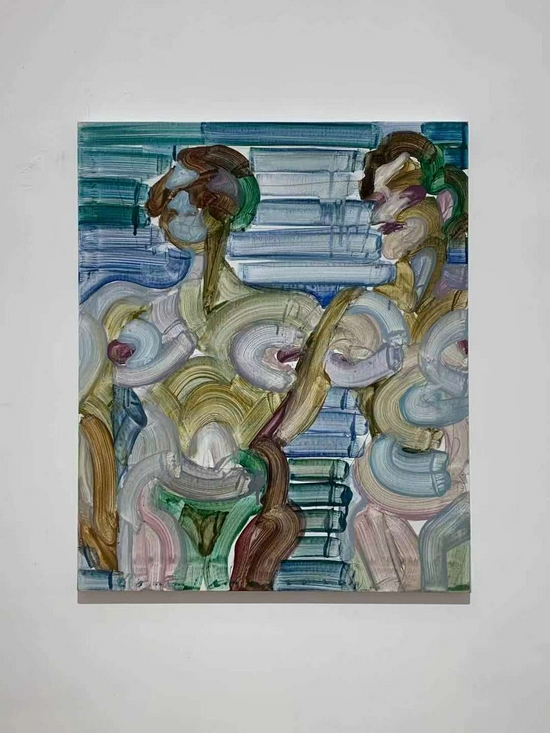
江上越个展“一期一会”现场 白石画廊香港-5 ⒸEtsu Egami
Faces are a primary subject matter for Etsu, who must have spent years staring into another’s eyes to try to figure out what they were saying to her as she traveled through the US, Europe and later China。 In these places where her native Japanese is neither spoken or readily understood, she personally encountered an inability to communicate。 Those moments where there was a total lack of communication—or understandings reach through voice tone and facial expression—are deeply rooted in this artist’s psyche。 So we encounter face-after-face, not a legacy of historic figures or a roster of contemporary celebrities, but ordinary folks that Etsu encounters along the way of preparing a show。
Depictions of faces are controversial and even dangerous these days。 There is a great deal of animosity towards facial recognition technology, for example, which people fear as a means of controlling activity and invading the subject’s privacy。 At the same time, people are posting an unlimited stream of “selfies” on social media, relinquishing any rights to privacy without care。 This pervasiveness of face-time is inspiring to Etsu, but also worthy of further investigation。 As opposed to Richard Prince who merely appropriated posts from Instagram, Etsu has reinvented how to approach a face, how to see a face and how to paint a face。 Most of all—as any of us looking at baby pictures or drivers’ licenses know—the face is ever-changing and ephemeral。 It ages, it acts out emotion, it may even reveal a kind of truth about the person。 But it is, unlike art, impermanent。 How to capture this quality without destroying portraiture?
Etsu Egami has been incorporating portraits into her installations since her graduation work, This is no a Mis-hearing Game (2016)。 Trying to capture the “sound” of communication as expressed on the face of her subjects, she started an interactive, socially engaged performance。 In it understanding among the participants deteriorates as they try to repeat the words said to them by the previous player。 In its completion, Etsu created a series of portraits of each of the participants。 These pictures are the beginning of rendering the face in broad strokes and sheer layers of paint, quite unlike Old Master paintings or contemporary realists。
In these loose interpretations of humanity, Etsu cleverly creates a “glitch” or visual white noise。 Images created by computer often have these glitches, e.g。 a deterioration into pixels or an erroneous smear of ink from a faulty printer。 Several painters have been trying to approach this new aesthetic because the fault lines of perfection offered by new media are much more interesting than the images produced seamlessly by software and apps。
In the Rainbow series from 2020, broad strokes of sheer colors emerge as features of a face against a backdrop of parallel lines, like a monitor on the fritz。 Or in her Social Distancing series, bodies come into focus from a haze of pastel clouds。 And in the series, Autre, famous authors are seen but not seeable, as if their power and influence has waned over time。 These various forms of “glitch” are meant to convey the ephemerality of time and the beauty of that impermanence。 Yet, no one approach is definitive or finite。 In Rainbows, there is the fleeting moment of a first encounter that never can be reenacted or preserved。 In Social Distancing, there is the mis-communications between human beings, the longing and desire that comes from distance, which according to the old phrase, “makes the heart grow fonder。” In Autre, fame and significance cannot always endure the passage of time, no matter what the glory and greatness of the subject’s achievements。 In fact, it is fascinating that Etsu has chosen authors who are known for their narratives packed with social commentary。 The artist herself is trying to achieve something akin to Zola or Tolstoy, simultaneously reinventing narrative as a metaphor for meaning。
All of these works were made in Beijing during the first wave of the pandemic when travel was impossible and their emphasis on time is particularly suited to the period of lockdown when we all had to live “one day at a time。” The pandemic frames these works and alters our initial understanding of the phrase, Ichi-go ichi-e 。 The aura of death hovers on the surface of these works, never requiring us to see its impact but the impact is there nonetheless。 Of the many paintings created in the past year。 Etsu Egami’s are some of the most meaningful。 Perhaps because it is embedded in her DNA, it seems that Etsu has been investigating a kind of social distancing—distance due to language or cultural differences—throughout her career。 She is not jumping on a bandwagon or worse yet, capitalizing on a worldwide disaster。 In her panopticon of faces, we see humanity。 These paintings make us want to meet those figures and start a conversation, maybe to perpetuate more confusion or maybe to find out that we are capable to bridge our differences and understand each other。